
HISTORY OF WOODVILLE
Located 10 miles Southwest of Idaho Falls, Idaho
And 3 ½ miles Northwest of Shelley, Idaho

First Woodville School 1897
In the summer of 1888, a small group of young married people living in Hooper, Utah, heard the stories of the vast Snake River Valley plains in Idaho and the possibilities of establishing homes there. After looking over the surrounding country, they decided to locate some ten miles southwest of Eagle Rock, (Now Idaho Falls). This was west of the Snake River and a large bed of Lava rock was easily seen further to the west. They filed claims in Eagle Rock and returned to build homes for their families. Only one woman came with that company, Mrs. Nancy A. Matthews, wife of Heber Matthews. ( Mrs. Matthews [1954] in her 85th year, said she was the only woman, in 1888, living on the west side of the river, between what was known as Market Lake to the north and Blackfoot to the south). The men were Heber Matthews, his brother William (Bill) Matthews, William Hammer and George Munsey. Historians state that George W. Gifford was with them. According to George W. Gifford's brief history, he states he came a month or two after, and came onto his friends, apparently unexpectedly, while exploring the west side of the Snake River. That same year, he took up a homestead near his friend's homesteads and commenced to build him a home, with the help of his friends. They then went back to Hooper to pick up their families. Those who followed in the years 1889, 90, 91 and 1892, were Brigham Matthews, brother to William and Heber, Joseph and Jasper Hammer, brothers to William Hammer along with their widowed mother, Sarah. Others were the Messervys, Henry Taysom, Jasper Wilson, John Everett and Henry Smith. Soon after this time, came Moses Gifford, brother to George W. and their aged parents, Henry Dill and Almira Ann Gifford and James Hale, brother-in-law to George W.
Not long after the arrival of the first families and homesteads taken up, it was decided to go out to the lava beds, which were less than one mile away and use the large abundance of dead cedar trees, gnarled and twisted in grotesque shapes and forms, for firewood. It was soon found out that this wood put out a lot of heat. (It is interesting to note here, in history written about some of these men before they came to Idaho, they would haul trees during slack time and sell it for firewood or trade for groceries. One wonders what they thought as they explored the west side and saw the abundance of the cedar wood. Good ground and water possibilities were probably not all they were looking for.) These hardy pioneers decided to haul the wood to Eagle Rock and trade it for groceries and clothes. There was a Grist Mill on the west bank of the Snake River, in Eagle Rock, which used wood as fuel to generate steam to turn the mill wheels in its process of flour making. It furnished a good market for the sought after cedar wood. Wood was used in most homes for fuel, also. Little money was in circulation and a lot of the wood was traded for flour. If the family's flour supply was more than needed, it was traded for other necessities. Soon the easy to get wood was used up, so they had to build roads out on the lava beds to get the cedar. The trips out on the lava beds were dangerous; horses cut their feet on the sharp rocks; wagon wheels broke when they became jammed down in the uneven cracks. Loose lava had to be hauled to fill in the larger cracks. Very seldom did they return without having some kind of accident. But cedar wood was in demand. Canals had to be built and families fed. When the ground was too frozen to dig the canal, it became a good time to put their horses, equipment and energy to hauling wood. Few settlers owned overshoes and when they did, the sharp lava made havoc of them. Sacks were wrapped around their feet to keep them warm. The snow made it easier to drive over the sharp rocks, but utmost care had to be taken to keep the horses from getting their feet and legs in the now hidden cracks. Round tubs were put on the wagons and sleighs to keep a fire, so they could keep warm.
 |
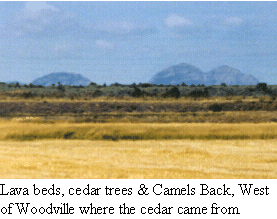 |
||
A townsite was picked, overlooking a high bank of the Snake River. Lots were sold to raise money. Those who put the townsite together, were each given a lot. The new community needed a new name. George W. Gifford gave a short speech, at a town meeting and said that because of the importance of the cedar wood to their livelihood, they ought to call the community, Woodville. No other name was submitted and it was voted that Woodville would be its name. George W. Gifford built a small home on the lot he had chosen in the community and in one room, he put in a small grocery store. It appears the first operator of the store was his father, Henry Dill. When his health was such that he could not operate it, George W. then moved down and took care of it for awhile, and then it was sold to his son, Alvin.
Pioneer life was hard--all the water used in their homes and for their stock had to be hauled from the river, or the stock had to be driven to the river. Water needed to be brought to their homesteads, the land seemed to be very fertile and productive, but extremely dry. These pioneers thought at first it would be possible to get their water from the Great Western District that was being developed to run through the valley. It had first been built for mining purposes and it was now being improved and extended. After looking over the fall of the Snake River, they decided it would be possible to take out a canal closer to their homesteads. With a straight edge board and a spirit level, George W. Gifford made a surveying instrument and with help of his neighbors, they surveyed the course for the new canal. They decided they had enough fall by heading their canal some three miles down the river from Idaho Falls, to take a stream of water to their farms.
Before starting the construction, they decided to get Joseph A. Clark to survey the system they had planned. He found that the grade and plans made with the homemade instrument were almost entirely correct and with few changes, the course of the new canal was decided on. Mr. Clark took his pay, in cedar wood.
Without capital and without assets upon which they could borrow money, these hardy pioneers made plans to construct an irrigation system and to build a dam across the mighty Snake River to bring precious water to their fertile soil. They divided the canal area in sections and drew, by lot, the section each was to build. With horses and slip scrapers, work was begun. Other interested settlers moved into the district and by united effort and hard work, they built a canal system. In the spring of 1893, after five years of hard toil, water was turned into the new canal and a decree of 4,275 miner inches was issued April 30th, 1893, to irrigate approximately 3,000 acres of land. By-laws were drawn up, the irrigation system was incorporated and some 600 shares of water issued to land owners, according to work done on construction. George W. Gifford was elected the first president of the Woodville Canal Company. From then on, maintenance assessments were almost always paid by labor on the canal, as very few had cash.
In 1904, came the Elmer Ames Huntsman family. Woodville was now 16 years old. Elmer bought a 40 acre farm and as he had been taught the skill of blacksmith from his father, he put together a Blacksmith Shop on his farm and it brought a much needed trade to the community. About this time, came James Montague, a carpenter by trade, and his skill was much used. Samuel Harris Hurst, came in 1904, also. He had recently, before moving to Woodville, married a widow with 7 children, Wilhelmina Klossner Risenmay, he also, having been left a widower with 8 children, now a family of 15. Others that came and added much to the communities stability were James Humphries Jr. in 1905 and John Chaffin in 1909 and about that same time period, came Charles Peter Burke, James P. Fugal, James Rider and James Cunningham. May we note here, even though most of the Pioneer's wives are not mentioned in this history, they were not one whit behind, certainly these Pioneer women contributed much in establishing of Community of Woodville.
In 1907, Idaho Falls took out their old steel frame river bridge. George W. Gifford states in his history, that he took around a petition to the then area residents, to present to the County Commissioners to see if that bridge could be purchased and put across the river at Woodville. The only two bridges were still in Idaho Falls and Blackfoot. The people of Woodville pledged to put up what they could, money-wise and then offered to haul it down. The Commissioners granted them the bridge. This made them much closer to a market in Shelley and the main North South Road, now known as the Yellowstone Highway, Shelley and the Highway was now only three and 1\2 miles away. A lot of cedar wood now could go to the thriving community of Shelley.

The first school was built in Woodville, around 1897, it being a one room schoolhouse built on the bank of the new Woodville Canal, about 1 & 1\4 miles north east of the townsite. The first year it had 7 students, the lowest grade being taught was First Grade and the highest was the Eighth Grade. Prior to this, school was taught in the homes. The desks were double desks, which sat two. There was a pot-belly stove in the center for heat. From the Teacher's Register at the Bingham County Court House, it shows that the first teacher taught there in 1897-98. He was Nathan S. Smith and received a salary of $40.00 per month. Other teachers who taught in the first school building were: Edith Lang, 1899; Ella Gibson, 1900; C.P. Anderson, 1900 and 1901-02; Emma True, 1902-03; J.R. Melville, 1904-05; William Bartlett, 1905-06-07; R.E. Moser, 1908-09; W.C. Jamison, 1909-10. In 1911-12, Edwin H. Cutler taught at a salary of $75.00 per month.
The year 1913, the students
met in the new yellow brick school house that was built on the
north end of the Woodville townsite. It was a two story, four
large room building, with the stairway going up the center of the
building. Three rooms in the school were used for classroom
instruction. They were known as the Little Room, which had grades
1 and 2, The 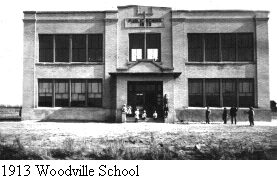 Middle
Room, which had grades 3,4 & 5, and the Big Room, which had
grades 6, 7 & 8. The fourth room, which was on the upper
level on the south side of the building was used for living
quarters for the teacher. Later, it was used as a kitchen--dining
room. There was a Belfry, with a large bell on top of the school
and it was quite a thrill to hear the bell ring to call the
children to school and from the recess and noon activities. The
children vied for the opportunity to ring the school bell. The
opportunity to ring the bell was sometimes used to reward
students. When Woodville started to send their children to High
School, in Shelley, is not known, but the Shelley High School was
built in 1915 and it was probably at this same time. The bridge
crossing the Snake River to Shelley was finished either in late
1907 or 1908.
Middle
Room, which had grades 3,4 & 5, and the Big Room, which had
grades 6, 7 & 8. The fourth room, which was on the upper
level on the south side of the building was used for living
quarters for the teacher. Later, it was used as a kitchen--dining
room. There was a Belfry, with a large bell on top of the school
and it was quite a thrill to hear the bell ring to call the
children to school and from the recess and noon activities. The
children vied for the opportunity to ring the school bell. The
opportunity to ring the bell was sometimes used to reward
students. When Woodville started to send their children to High
School, in Shelley, is not known, but the Shelley High School was
built in 1915 and it was probably at this same time. The bridge
crossing the Snake River to Shelley was finished either in late
1907 or 1908.
Another School District was formed about 1 & 1\2 miles southwest of the Woodville School. It served the same community, but in the southwestern portion of the community. By the action of a few positive-thinking pioneers, a school site was established, and education secured over the ensuing forty two years for their children and posterity of at least two generations. The school location was in the southwest corner of the southwest quarter in Section 19 Township 1 North 37 EBM.
In 1903, a dozen pioneer landowners petitioned the Bingham County Commissioners for the creation of a school district, which petition was granted and the School District #51 was assigned.
The first three person board of trustees, appointed by the superintendent of county schools were: W.B Smith, chairman; Polly Bowmen, Clerk; and Thomas Owens. An election was called for thereafter, to determine whether bonds should be issued that a schoolhouse might be erected. The election proved favorable, whereby bonds of $1,500 were issued, the proceeds of which did go to erect a structure 28 by 60 feet, with a six foot entrance hallway. A belfry was put in place, and a flagpole. Mr W.W Keifer, the hired contractor, built the one-room building with one classroom, capable of providing the setting for all eight grades, if represented at a given time. The completed building was readied for 1904 school term.
Items purchased for the school, deserving attention, because of price tag notation are these: wash basin 30 cents, soap 15 cents, one dozen towels 50 cents, broom 30 cents, school map $1.15, water bucket 35 cents, dipper 10 cents, an ax $1.25, coat hooks 30 cents, comb 15 cents, window shade $4.70, lock 10 cents, books 60 cents and a chair $1,50.
In one of the early meetings of the board, the issue was what to name the school. The proposal was given to name the school Taysom, honoring H.C. Taysom Sr. who had donated 2.1 acres of ground for the school site. The suggestion was duly voted on and unanimously passed on. The names participating in this matter have been preserved, and warrant mention here of these, were the parents of school children enrolled during the years of operating this school, in a substantial way. Their names follow: H.B Taysom (Sr. & Jr.) Minnie Hughs, Jay Hughs, Millie Matthews, Brigham Matthews, Thomas Owens, M.L. Owens, Martha Robinson, Maggie Smith, W.B. Smith, Poly Bowman, Hattie Wilcox.
Major improvements were constructed adding to the operation of the school. For instance, by 1925 there were two classrooms, with two teachers hired; a stable had been erected to house a team of horses which pulled the school wagon or the sleigh in bringing the pupils to school and returning them to their homes after school. A central heating system was placed in the basement and electricity replaced kerosene lamps.
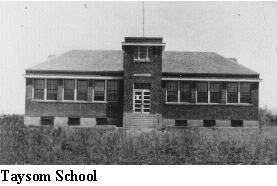 During the operation of the school at
Taysom, it is estimated that 275 students graduated from the
eighth grade between 1904-1946.
During the operation of the school at
Taysom, it is estimated that 275 students graduated from the
eighth grade between 1904-1946.
TAYSOM SCHOOL DISTRICT #51 TEACHERS
1903-05 Lillie Anderson; 1905-06 Edna Long; 1906-07 Frank E. Lord; 1907-08 J.H. Melville; 1908-09 Lenore Butts; 1909-10 Marie Harkness; 1910-11 Adeline Lester; 1911-12 B.F. Reddick; 1912-13 Melvin Morgan, Irene Kar; 1913-14 Miss T.M. Ennor, Mrs. Ray Dietrich; 1914-15 Adele Currier, Jennie Rosander; 1915-16 Ora Rich; 1916-20 Mrs. Carl F. Johns, Mae Nebergal (Peterson); 1920-21 LaRue Smith, Rosa Loveless; 1922-23 Emma Bruveleit (Thompson), Miriam Pearson; 1923-24 Emma Bruveleit Thompson, Maud Leeper, Erma T. Duffy; 1924-25 Stella Yost Burke, Irma Duffy, Mattie Christensen. 1925-26 Norval B Hawk, Gladys Nilsson; 1926-27 Norval Hawk; 1927-28 Edward G. Sarback, Eva Hansen; 1928-29 Ora Holland, Eva Hansen; 1929-30 Ora Holland, Sadie Fisher; 1930-31 Richard F. Wilkie, Ruth Esplin, Ruth Cederberg (Carlson); 1931-32 Richard F, Wilkie, Ruth Esplin; 1932-33 Grover Jensen; 1933-40 Melvin Ison; 1934-40 Leta Wells Ison; 1935-37 Golda Hanks; 1940-41 Dallas Peterson: 1941-42 Dallas & Austin Peterson; 1942-43 Daniel T Alridge, Ruby Hanft; 1943-44 Lenore Hammer; Dora Everett Anderson and Olga Everett Adolphson were also teachers.
Many things caused the lives of the pioneer families to be closely knit together, they having to depend on each other for help in many ways, but one big thing was their religion, most of them being Mormons. In 1894, Woodville was made a branch of the Eagle Rock Ward, which belonged to the Bingham Stake, at that time. Church and Primary were first held in the various homes and later, in the one room Schoolhouse. Jasper Hammer was appointed Presiding Elder of the Branch and served in that capacity until 1904, when Woodville was organized into a
Ward, then he was made Bishop. (Also at this time the Stake became the Blackfoot Stake and was such until 1914, when it became the Shelley Stake). While Bishop Hammer was Bishop, a lot was purchased on the townsite and a white frame Cultural Hall and Chapel was built in 1906. It was one large room and curtains were used to separate the classrooms. It served as the Chapel and Hall until the red brick Chapel was built in 1919, across the street and on the west side of the two story School House. This was done during the administration of Bishop Joseph P. Bischoff.
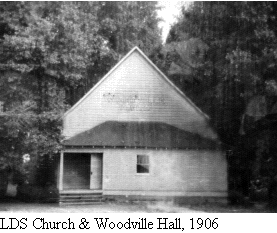 |
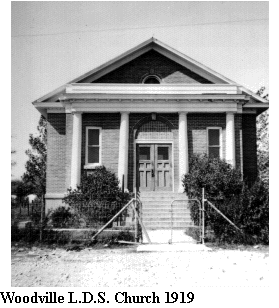 |
||
 Vern Huntsman had bought the
Woodville Store from Alvin Gifford and owned and operated it for
many years and when World War Two was over, Vern sold it to his
son, Boyd. After several years running it, Boyd took employment
with Continental Oil and sold the store to Floyd Tew. Floyd Tew
ran it for several years and then bought an auction yard in Deer
Park Washington and sold it to Eldon Thompson. After several
years of running the store Eldon Thompson built a furnace and air
conditioning shop next to his home on the New Sweden Highway in
Woodville and sold it to Elmo Fackrell. Elmo Fackrell still owns
it today, 1993. Gas is also sold there, and has been so, for many
years. Some of us still remember when we used to have to hand
pump the gas up to the top of the pump tank and there it was
measured in a marked glass container and then gravity fed back
down to the car's gas tank. The store still remains small and the
living quarters are still attached to it.
Vern Huntsman had bought the
Woodville Store from Alvin Gifford and owned and operated it for
many years and when World War Two was over, Vern sold it to his
son, Boyd. After several years running it, Boyd took employment
with Continental Oil and sold the store to Floyd Tew. Floyd Tew
ran it for several years and then bought an auction yard in Deer
Park Washington and sold it to Eldon Thompson. After several
years of running the store Eldon Thompson built a furnace and air
conditioning shop next to his home on the New Sweden Highway in
Woodville and sold it to Elmo Fackrell. Elmo Fackrell still owns
it today, 1993. Gas is also sold there, and has been so, for many
years. Some of us still remember when we used to have to hand
pump the gas up to the top of the pump tank and there it was
measured in a marked glass container and then gravity fed back
down to the car's gas tank. The store still remains small and the
living quarters are still attached to it.
In 1943 Shelley School District consolidated its schools and all the outlying schools were closed down, which included Woodville and Taysom Schools. The grade school children were bussed to Shelley. The High School kids had been going to Shelley every since the first High School was built in Shelley soon after the Woodville bridge was put in.
Due to the rapid growth of the Ward population, plans for remodeling the Chapel were discussed during Bishop E. Delos Huntsman's administration. Construction was started July 30th, 1951, and partly built during the service of Bishop Victor Kotter. Bishop Vernard Huntsman carried on the work and brought it to completion. The Chapel was constructed entirely new and erected adjacent to and on the north side of the old Chapel. The old portion of the building was converted into a recreation hall and classrooms. The new Chapel and remodeled part was dedicated on Sunday, June 21, 1953, by Mathew Cooley of the Council of the Twelve. The old white wood frame Cultural Hall was sold to Vern Huntsman and he remodeled it into apartments. Construction on the present, entirely new, Chapel was started on September 10th, 1967 and was completed in the spring of 1968. It was started and completed under administration of Bishop Dean G. Huntsman. This new Chapel was constructed where the 2 story, 4 room School House used to stand, it having been abandoned in 1943 and torn down a few years later. The Church having purchased the property, for later development. The old Chapel was sold and has been remodeled into apartments. Today (1993), there are two Wards, Woodville 1st and 2nd Wards.
 |
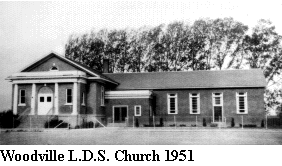 |
Woodville Bishoprics
1904 to 1906: Bishop Jasper Hammer with M.K. Hammer and Samuel Hurst as Counselors and Jessie Beckstead as Clerk.
1906 to 1910: Bishop John Rider with Samuel Hurst, Sr. and George R. Moses as Counselors and Elmer A Huntsman as clerk.
1910 to 1916: Bishop James P. Fugal with M.K. Hammer and Samuel Hurst, Jr. as Counselors; Elmer A. Huntsman as Clerk
1916 to 1928: Bishop Joseph P. Bischoff with Lorenzo Christensen, George H. Risenmay, John Chaffin, Evon W. Huntsman, Winfield Hurst, and Cecil A. Call as Counselors; Will Montague and Elmer A. Huntsman as clerks.
1928 to 1940: Bishop George H. Risenmay with Cecil A. Call, Victor M. Kotter, Eugene Cobbley, Wesley Hurst, E. Delos Huntsman as Counselors; John Everett as Clerk.
1940 to 1946: Bishop E. Delos Huntsman with Roy Summers, Walter Christensen, Gordon Burke and Victor Kotter as Counselors; Reid Bischoff, Daniel Aldridge and Claude E. Rhead as Clerks.
1946 to 1951: Bishop Victor M. Kotter with Howard L. Risenmay and Lawrence Sparks as Counselors; Claude Rhead and James Fugal as Clerks.
1951 to 1956: Bishop Vernard Huntsman with Charles Shumway, Dean G. Huntsman, and Delbert L. Clayson as Counselors; Charles Hammer and Joseph A. Balmforth as Clerks.
1956 to 1960: Bishop Charles H. Shumway with Delbert Clayson and Claude E. Rhead as Counselors; Eldon Risenmay, Eldon Killian, Gilbert Davis and Harry Thompson as Clerks.
1962 to 1969: Bishop Dean G. Huntsman with Eldon Thompson, Neil Baird, Neil B. Kelley and Merwyn M. Searle as Counselors. Dean H. Shumway, Charles Hammer, Roger Nuttall, Harry Thompson and Wallace Walker as Clerks.
1969 to 1975: Bishop Eldon Thompson with Eugene Humphries, Dee Risenmay, Norman Kelley as Counselors. George Murray and Orin Markem as Executive Secretery, Dean Shumway, Charles Hammer and Elmo Fackrell as Clerks.
1975 to 1983: Bishop Merwyn Searle with Eldon Risnmay, Karl Kelley, Brad Risnmay, Doyal A. Rumsey, Clayton C. Rich, and Dee Larsen as Counselors. Orim Marken as Executive Secretery. Eugene Wheeler, Delen Steers, Charles Hammer and Tom Murdock as Clerks.
1983 to 1988: Bishop Karl B. Kelley with Richard Ambrosek, Brent Shumway and Darrel Herndon as Counselors. Eugene Wheeler as Executive Secretery. Charles Hamer and Adrian Sparks as Clerks.
1988 to 1993: Bishop Patrick McCabe with Eugene E. Wheeler, Willard Price and Eugene Humphries as Counselors. Darrel Herndon as Executive Secretery. Lee Shumway, Adrian Sparks and Ardery Andrews as Clerks.
1993 to Jan. 1999: Bishop Thomas Ray Murdock with Marlyn Jan Nelson and Stanley Curtis Searle as Counselors. Richard Garry Ambroske as Executive Secretary. Ward Clerk, Kris Brent Kelley. Assistent Ward Clerk, DeLen Stears. Financial Clerk, Adrian L. Sparks.
Jan. 1999 to ---------: Bishop Charles Brent Shumway. Robert Roland Johnson & Chris Brent Kelley, Counselers. Mickael John Klements, Executive Secretary & Rowland Thompson, Ward Clerk. Assistant Clerks, Gerald Dean Richards, DeLen Thomas Stears & Lee Hart Shumway. Finance Clerk, Adrian Lawrence Sparks, Todd Norman Kelley. Assistant Finance, Thane Derril Sparks, Russell Ray Gold
WOODVILLE SECOND WARD was Organized January 18, 1981, and was made up by taking Members partly from Woodville First Ward and Shelley First Ward and they meet in the same building as Woodville First Ward in Woodville, Idaho.
1981 to 1983: Bishop Thayne S. Huntsman with Alan Cannon Jr., Gordon Rigby and James Roger Nuttall as Counselors. Keith Hansen, Executive Secretary and Stan Verl Ottley, Ron Brown, Elmo Fackrell, Bruce Russell and Errol Huntsman as Clerks.
1983 to 1988: Bishop Darwin G. Mathews with John Clinger and Alan Canon Jr. as Counselors. Garl Miller as Executive Secratery and Ron Brown, Stan Verl Ottley, Erral Huntsman, Rush Nuttall, Jerald Petty, Bruce Russell and Larry Murray, as Clerks.
1988 to October 24, 1993: Bishop Doyal Rumsey with Dale R. Huntsman and Melven J. Wheeler as Counselors. Thiel Gomm as Executive Secratery and Jerald Petty, Karl Kotter, Rush Nuttal and Norm Stanely as Clerks.
1993 to -----: Bishop Allan M. Cannon with Mark Leo Searle and Jack Hutchens Grover as Counselors. George J. Lake as Executive Secretery. Assistent Executive Secretery, Bryan Vance Bush. Ward Clerk, Robert Bruce Buttler. Finance Clerk, Karl L. Kotter. Membership Clerk, David Albert Clinger.